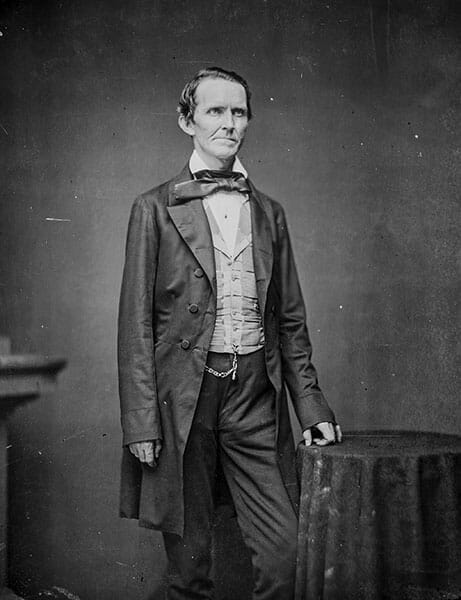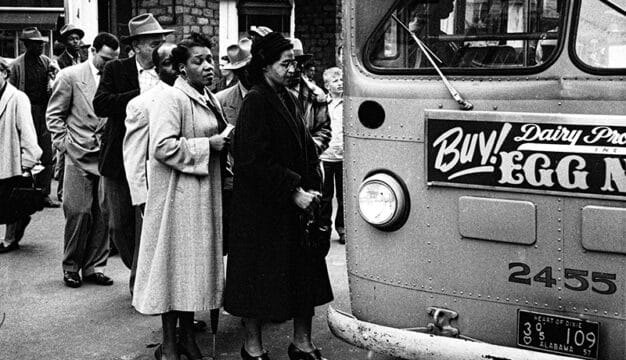Sydenham Moore
Sydenham Moore (1817-1862) represented Alabama’s Fourth Congressional District from 1857 until 1861, when he left Congress after Alabama seceded from the Union. A veteran of the Mexican-American War, he joined the Confederate States Army and rose to the rank of major. He died from wounds received during the 1862 Battle of Seven Pines, in Virginia.
 Sydenham Moore
Moore was born in Rutherford County, Tennessee, on May 25, 1817, to Alfred Moore and Eliza Jones Moore. Alfred, a minister, possibly later remarried, in 1836 a woman named Mary Jane Watson, according to some sources. Sydenham may have had five siblings. His oldest sister, Mary Olivia Moore, married Edward Asbury O’Neal, a future brigadier general in the Confederate States Army and governor of Alabama (1882-1886). After Moore’s birth, the family moved to Limestone County, in 1818. He attended the University of Alabama (UA) in Tuscaloosa, Tuscaloosa County, from 1833-1836. Like many upper-middle-class southerners of the early American republic, Moore was fascinated by the classical traditions of ancient Greece and Rome. He pursued classical studies while at UA and eventually studied law. Moore was then admitted to the state bar and began practicing law in the town of Greensboro, Greene County (now in Hale County). His interest in the law eventually led him into the judiciary when he became a judge in the Greene County in 1840. In 1841, he married Amanda Melvina Hobson, with whom he would have nine children. He served as a judge until 1846 and then again from 1848-1850.
Sydenham Moore
Moore was born in Rutherford County, Tennessee, on May 25, 1817, to Alfred Moore and Eliza Jones Moore. Alfred, a minister, possibly later remarried, in 1836 a woman named Mary Jane Watson, according to some sources. Sydenham may have had five siblings. His oldest sister, Mary Olivia Moore, married Edward Asbury O’Neal, a future brigadier general in the Confederate States Army and governor of Alabama (1882-1886). After Moore’s birth, the family moved to Limestone County, in 1818. He attended the University of Alabama (UA) in Tuscaloosa, Tuscaloosa County, from 1833-1836. Like many upper-middle-class southerners of the early American republic, Moore was fascinated by the classical traditions of ancient Greece and Rome. He pursued classical studies while at UA and eventually studied law. Moore was then admitted to the state bar and began practicing law in the town of Greensboro, Greene County (now in Hale County). His interest in the law eventually led him into the judiciary when he became a judge in the Greene County in 1840. In 1841, he married Amanda Melvina Hobson, with whom he would have nine children. He served as a judge until 1846 and then again from 1848-1850.
After the United States declared war on Mexico in May 1846, Moore recruited volunteers to fight from his law office in Eutaw on the Greene County courthouse square. His recruits made up a unit of soldiers that came to be known as the “Eutaw Rangers.” Moore’s volunteers went aboard a steamboat at Finches (sometimes Finche’s) Ferry Landing in Greene County on the Black Warrior River and headed for Mobile, Mobile County, before eventually embarking on another steamship bound for Mexico. The Eutaw Rangers joined up with the First Regiment of Alabama Volunteers led by Col. John R. Coffey (or Coffee) and were stationed at Camp Belknap. Future representative William Henry Forney also was a member of this unit.
While at the camp, Moore’s Rangers cared for sick and wounded soldiers, and many eventually succumbed to disease themselves. The enslaved person, Peter, who accompanied Moore was one of the victims, and Moore lamented his death in a letter to his wife. Peter and the other deceased members of Moore’s unit were buried in northern Mexico. Moore’s Alabamians stayed at the camp without seeing much combat compared to other units. Then, they were called upon to contribute to Gen. Zachary Taylor’s 20-day siege of Veracruz in March 1847. The city siege consisted of an amphibious assault and a cannonade bombardment led by Capt. Robert E. Lee. In this conflict, Moore gained military experience that would lead to his commissioning as an officer in the Confederate Army during the Civil War.
After returning from Mexico, Moore resumed the practice of law. In the early 1850s, he ran unsuccessfully on at least two occasions for the Fourth Congressional District seat that was held and won by William Russell Smith, who was variously a Whig, Union Democrat, and Know-Nothing. The 1860 Census lists Moore as a planter as well as a lawyer. In 1855, Moore built a two-story Greek Revival home with four Ionic columns and two-bays windows on the 2200 block of Main Street in Greensboro. In its construction, he used material from the dismantled home of Israel Pickens, Alabama’s third governor. After Moore’s death, it reportedly passed to the heirs of Pickens. It was known as the W. C. Pickens House when it was documented by the Historical American Building survey in 1934 and later as the Greenwood-Sydenham Moore Home when it was listed on the Greensboro Historic District that was established by the National Register of Historic Places in 1976.
Later, the states’ rights Democrat Moore defeated Smith and served in the 35th and 36th Congresses, from March 4, 1857 until January 1861. Smith’s vote to censure South Carolina representative Preston Brooks for his brutal caning of Massachusetts senator Charles Sumner in May 1856 was used against him during the campaign. The strongly abolitionist Sumner had just recently denounced slavery during a debate over whether Kansas should be admitted as a slave state or free state. Indeed, early in his term, Moore defended Alabama, the South and slavery, rebuked abolitionists, and warned northern lawmakers about the resolve in the South in a speech on the admission of Kansas. The speech was published under the title; Speech of the Hon. Sydenham Moore, of Alabama, Delivered in the House of Representatives, 25th March, 1858, on Kansas, and the Evil Effects of the Slavery Agitation. On January 21, 1861, he withdrew from Congress, along with other members of the Alabama delegation, following Alabama’s vote to secede on January 11. The congressional district was inactive until 1868, when Republican Charles Wilson Pierce was elected, during Reconstruction.
Moore’s military experience earned him the rank of colonel in the Confederate Army during the Civil War. He organized and led the Eleventh Alabama Regiment of volunteer infantry that was at first attached to Gen. Edmund Kirby Smith’s brigade and stationed in Northern Virginia. The Eleventh fought in their first major action at the May 31-June 1, 1862, Battle of Seven Pines. Moore was wounded twice on the 31st and was among the 49 members of the unit who were wounded; nine were killed. His wounds proved to be fatal, and he died on August 18 or 20 (sources differ, and some say May 31) at a field hospital near Richmond, Virginia. Moore’s loss was described as “scarcely reparable” by his commanding general. Future governor Edward O’Neal was also wounded at Seven Pines, leading the Twenty-sixth Alabama Infantry. Moore’s son Alfred was killed at the 1863 Battle of Chickamauga in Georgia.
Sydenham Moore’s body was eventually returned to the state of Alabama. He is buried in the City Cemetery at Greensboro. The Alabama Department of Archives and History in Montgomery, Montgomery County, has in its collection a diary Moore kept and letters he penned to wife while in Mexico and later in Virginia during the Civil War, including one written about a week before he suffered his fatal wounding.
Further Reading
- Dorman, Lewy. Party Politics in Alabama from 1850 Through 1860. Tuscaloosa: University of Alabama Press, 1995.



